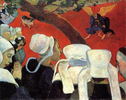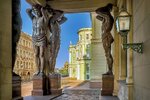the crown is worthy of snowhite...
You are using an out of date browser. It may not display this or other websites correctly.
You should upgrade or use an alternative browser.
You should upgrade or use an alternative browser.
Alton Towers, Sir Francis Bacon and the Rosicrucians
- Thread starter MJF
- Start date
moyal
Jedi Master
Her name in German is actually 'Schneewittchen'....snowhite...
'Schneeweißchen und Rosenrot' (Snow-White and Rose-Red) is another tale.
-> Snow White - Wikipedia
..It is made of gold with diamonds, rubies, emeralds, sapphires, enamel and pearls...
The crown is made up of 12 hexagonal rosettes on the base each supporting a gold stem topped by a lily. The stems and lilies alternate in size and height. They are heavily jewelled versions of the fleur de lys (lily flower) that was popular for medieval crowns. In the middle of the hexagons, which have enamelled white flowers overlaid onto a translucent blue or red background, is a pale blue sapphire, 11 of which are oval and 1 is hexagonal. Each point is decorated with alternating rubies and clusters of four pearls that have a small diamond at the centre. In addition to diamonds, pearls, and sapphires, the lilies are also decorated with emeralds.
I think both you and Bluegazer have made a good catch here. I would suggest that the crown with 12 hexagonal rosettes made of gold with diamonds, rubies, emeralds, sapphires, enamel and pearls can also be indirectly linked with the Israelite High Priest's ephod that was called the 'Breastplate of Judgement', which the High Priest wore when in the presence of the Ark of the Covenant. The breastplate consisted of four rows of inlaid precious jewels or gemstones:
I think both you and Bluegazer have made a good catch here. I would suggest that the crown with 12 hexagonal rosettes made of gold with diamonds, rubies, emeralds, sapphires, enamel and pearls can also be indirectly linked with the Israelite High Priest's ephod that was called the 'Breastplate of Judgement', which the High Priest wore when in the presence of the Ark of the Covenant. The breastplate consisted of four rows of inlaid precious jewels or gemstones:
“It is to be square – a span long and a span wide – and folded double. Then mount four rows of precious stones on it. The first row shall be Carnelian, Chrysolite and Beryl; the second row shall be Turquoise, Lapis Lazuli and Emerald; the third row shall be Jacinth, Agate and Amethyst; the fourth row shall be Topaz, Onyx and Jasper. Mount them in gold filigree settings. There are to be twelve stones, one for each of the names of the sons of Israel, each engraved like a seal with the name of one of the twelve tribes.” Exodus 28:16-20
Used to communicate with God, the Breastplate was originally worn by Aaron, elder brother of Moses [MJF: a fiction according to the C's]. Known as the Priestly Breastplate, or the Breastplate of Judgement, it contained the ‘Urim’ and ‘Thummim’, two stones used to determine God’s will. Well we know who may have been the so called god or deity the High Priest was unwittingly communicating with.
The Jewish scholar Josephus realised that the number twelve had huge significance. From the twelve stones on the Breastplate, to the twelve gemstones mentioned in the Book of Revelation (c.69-96AD), to the number of the sons of Israel, to the signs of the Zodiac [MJF: this number has varied over the ages though], and the months of the Roman calendar year. Hence, it is interesting that the Crown of Blanche should have 12 hexagonal gold rosettes within it, each supporting a gold stem topped by a lily, which are heavily jewelled versions of the fleur de lys (the lily flower).
The 'Fleur de Lis' is itself an interesting symbol since it may have an underlying connection to the triad looking plasma discharges that can occur in nature, which can resemble a trident (Trent?) in appearance. As the C's said, our ancestors may have seen such plasma discharges in the sky and been in awe of them. The Fleur de Lis is supposedly based on the lilly flower, which is also the symbol of the House of David and of the Virgin Mary and Saint Joseph (who was descended from the House of David) who is often depicted with a lily.
Nobody knows for certain when the Fleur De Lis symbol was first designed, though it has been found on seals and coins dating as far back as the 10th century A.D.
However, some French scholars believe the flower may originally have been an iris (see below). Apparently, the French or Franks, before entering Gaul, had lived for a long time around the river named Lys in Flanders. Nowadays, this river is still bordered with an exceptional number of irises which have yellow flowers, which is not a typical feature of lilies. The Fleur de Lis was the symbol found on the French Royal Standard or flag until it was replaced in the French Revolution by the Tricolour. Many noble Norman families also adopted the Fleur de Lis within their family crests and my own Norman family was no exception.
The Jewish scholar Josephus realised that the number twelve had huge significance. From the twelve stones on the Breastplate, to the twelve gemstones mentioned in the Book of Revelation (c.69-96AD), to the number of the sons of Israel, to the signs of the Zodiac [MJF: this number has varied over the ages though], and the months of the Roman calendar year. Hence, it is interesting that the Crown of Blanche should have 12 hexagonal gold rosettes within it, each supporting a gold stem topped by a lily, which are heavily jewelled versions of the fleur de lys (the lily flower).
The 'Fleur de Lis' is itself an interesting symbol since it may have an underlying connection to the triad looking plasma discharges that can occur in nature, which can resemble a trident (Trent?) in appearance. As the C's said, our ancestors may have seen such plasma discharges in the sky and been in awe of them. The Fleur de Lis is supposedly based on the lilly flower, which is also the symbol of the House of David and of the Virgin Mary and Saint Joseph (who was descended from the House of David) who is often depicted with a lily.
Nobody knows for certain when the Fleur De Lis symbol was first designed, though it has been found on seals and coins dating as far back as the 10th century A.D.
However, some French scholars believe the flower may originally have been an iris (see below). Apparently, the French or Franks, before entering Gaul, had lived for a long time around the river named Lys in Flanders. Nowadays, this river is still bordered with an exceptional number of irises which have yellow flowers, which is not a typical feature of lilies. The Fleur de Lis was the symbol found on the French Royal Standard or flag until it was replaced in the French Revolution by the Tricolour. Many noble Norman families also adopted the Fleur de Lis within their family crests and my own Norman family was no exception.
And as Bluegazer noted the three-pronged Ψ sign represents the PSY symbol and the wave function in quantum mechanics and is also a symbol for Antennae in electronics. Hence, there could have been an ancient, occulted scientific principle underlying the Ψ symbol, which subsequently found expression in the Fleur de Lis.
However, say if the crystal skull the Templars called Baphomet was a triple faced skull that was the Grail, which through its pure crystal composition was capable of acting as a powerful receiver or antenna that allowed for the fine tuning of signals coming from vast distances in the way that radio telescopes are today. In turn, could the gemstones incorporated within the High Priest's Breastplate of Judgement have been a means of passing on messages transmitted via Baphomet, where the different gemstones would light up to signify what the message might be and the High Priest could then interpret them (in a similar way perhaps to how a Ouija board operates today).
If so, is it possible that English author Graham Phillips and his American friends the Russells may have found some of the missing gemstones from the original Breastplate of Judgement that seemingly made their way to Warwickshire in England after the English Templar Knight Ralph de Sudely had discovered them in the Holy Land and brought them back with him as sacred relics that were then put on display at the Templar chapel at Temple-Herdewyke until the Black Death wiped that Templar community out in the mid-14th century? Phillips claims in his book The Templars and the Ark of the Covenant that the gemstones displayed some very unusual properties including emitting energy that left clear marks on photographic paper even when they were stored in the dark and leaving red marks on Phillip's hand after he had handled them.
However, Phillips and his friends also found a broken stone slab with highly unusual rune like symbols inscribed on it that could have been the remains of one of the Stones of Testimony on which the Biblical Ten Commandments were supposed to have been written. Although experts at the British Museum were unable to identify the stone script, could it have been a form of proto-runic script, which eventually evolved into the later runes linked with the Gaels and the Scandinavians that Bluegazer displayed in his post above?
We should recall here that the C's confirmed that Abraham/Moses was a Hittite/Levite. On this question of an unknown script, it recently came to my attention that the Hittites were capable of writing in several contemporary scripts, five of which are known - see: MSN
Quoting from that article:
Ongoing excavations in Turkey – in the ruins of the ancient capital of the Hittite Empire – are yielding remarkable evidence that the imperial civil service included entire departments fully or partly dedicated to researching the religions of subject peoples. [MJF: Could these have included those of the Sabians of Haran and the Zoroastrians perhaps?]
The latest example was unearthed just two months ago. It turned out to be written in a previously unknown Middle Eastern language that had been lost for up to 3,000 years.
Over the decades, around 30,000 complete and fragmentary clay tablet documents have been unearthed in the ruins of the ancient Hittite capital – Hattussa (now known as Bogazkoy) around 100 miles east of modern Turkey’s capital, Ankara.However, say if the crystal skull the Templars called Baphomet was a triple faced skull that was the Grail, which through its pure crystal composition was capable of acting as a powerful receiver or antenna that allowed for the fine tuning of signals coming from vast distances in the way that radio telescopes are today. In turn, could the gemstones incorporated within the High Priest's Breastplate of Judgement have been a means of passing on messages transmitted via Baphomet, where the different gemstones would light up to signify what the message might be and the High Priest could then interpret them (in a similar way perhaps to how a Ouija board operates today).
If so, is it possible that English author Graham Phillips and his American friends the Russells may have found some of the missing gemstones from the original Breastplate of Judgement that seemingly made their way to Warwickshire in England after the English Templar Knight Ralph de Sudely had discovered them in the Holy Land and brought them back with him as sacred relics that were then put on display at the Templar chapel at Temple-Herdewyke until the Black Death wiped that Templar community out in the mid-14th century? Phillips claims in his book The Templars and the Ark of the Covenant that the gemstones displayed some very unusual properties including emitting energy that left clear marks on photographic paper even when they were stored in the dark and leaving red marks on Phillip's hand after he had handled them.
However, Phillips and his friends also found a broken stone slab with highly unusual rune like symbols inscribed on it that could have been the remains of one of the Stones of Testimony on which the Biblical Ten Commandments were supposed to have been written. Although experts at the British Museum were unable to identify the stone script, could it have been a form of proto-runic script, which eventually evolved into the later runes linked with the Gaels and the Scandinavians that Bluegazer displayed in his post above?
We should recall here that the C's confirmed that Abraham/Moses was a Hittite/Levite. On this question of an unknown script, it recently came to my attention that the Hittites were capable of writing in several contemporary scripts, five of which are known - see: MSN
Quoting from that article:
Ongoing excavations in Turkey – in the ruins of the ancient capital of the Hittite Empire – are yielding remarkable evidence that the imperial civil service included entire departments fully or partly dedicated to researching the religions of subject peoples. [MJF: Could these have included those of the Sabians of Haran and the Zoroastrians perhaps?]
The latest example was unearthed just two months ago. It turned out to be written in a previously unknown Middle Eastern language that had been lost for up to 3,000 years.
The great majority were written in the empire’s main language – Hittite. But the Hittite government’s scribes wrote around 5 per cent of them fully or partly in the languages of the empire’s minority ethnic groups – peoples like the Luwians (south-eastern Anatolians), Palaians (from part of north-west Anatolian), Hattians (central Anatolians) and Hurrians (from Syria and northern Mesopotamia).
The most recently discovered minority language, recorded by government scribes (and previously unknown to modern scholars) is being called Kalasmaic – because it seems to have been spoken by a subject people in an area called Kalasma on the empire’s north-western fringe.
The empire’s civil service scribes wrote all their manuscripts in a Hittite version of a pre-existing Mesopotamian-originating script (the oldest writing system in the world) called cuneiform, consisting of wedge-shaped lines arranged in groups representing syllables.The area of the Middle East which is now Turkey was, in ancient times, particularly rich in languages.
Linguistic diversity often depends on topography. The more mountains and isolated valley systems, the more languages are likely to develop and survive.
At present only five minority languages are known from the Bronze Age Hittite empire – but in reality, given the mountainous topography, there may well have been at least 30.
Indeed, just adjacent to the ancient Hittite Empire were the Caucasus mountains region which still today boasts some 40 languages.
The Hittite language is the world’s oldest attested Indo-European tongue.
The earliest inscriptions date from the 16th century BC. As an Indo-European language, it is related to most modern European languages (including English) as well as many Asian languages (including Iranian and many Indian ones). Indeed, despite the 3,000-year time gap, ancient Hittite and modern English have dozens of words in common.
Watar was for instance Hittite for “water”. Duttar was the main part of the Hittite word for “daughter”. “Wine” was wiyana, while card was “heart/cardiac” and newa was their word for “new”.
Given what is said above, is it possible that the Hittite Abraham/Moses may have been responsible for inscribing the Tablets of Testimony in an unknown Hittite script akin to a primitive Ogham or Runic script? Could this ancient script have even been written in the alphabet of the exiled Trojans who had originally come from Britain?
King Solomon
As to King Solomon and the Seal or Sigel of Solomon, we should not lose sight of what the C's have told us and that was that there never was an Israelite king called Solomon and his character was based instead on the Egyptian pharaoh called Narmer who famously united the two kingdoms of Egypt, which as Laura noted occurred around the same time as the formation of the "Elohim Covenant" with the Rosteem (Rosicrucians), which may in turn be related to the Nordic Covenant:
Q: Was Solomon a king of Egypt?King Solomon
As to King Solomon and the Seal or Sigel of Solomon, we should not lose sight of what the C's have told us and that was that there never was an Israelite king called Solomon and his character was based instead on the Egyptian pharaoh called Narmer who famously united the two kingdoms of Egypt, which as Laura noted occurred around the same time as the formation of the "Elohim Covenant" with the Rosteem (Rosicrucians), which may in turn be related to the Nordic Covenant:
A: Yes.
Q: Which king of Egypt was the equivalent of Solomon?
A: Narmer.
This suggests that the Seal of Solomon may originally have been an Egyptian symbol that went with the Israelites during their Exodus from Egypt under the leadership of Moses.
In my earlier post, I mentioned how Solomon was supposed to have harnessed through a magic ring or talisman the advanced talents, knowledge and skills of demons led by Asmodeus to build his temple. This may simply be a flowery explanation for Narmer obtaining assistance from certain aliens (was one of these an alien grey who called himself Ptah who possessed a magic levitating throne?). This connection between Narmer and aliens may be gleaned from the following exchange between the C's and Laura:
Q: Who was the Queen of Sheba? In my earlier post, I mentioned how Solomon was supposed to have harnessed through a magic ring or talisman the advanced talents, knowledge and skills of demons led by Asmodeus to build his temple. This may simply be a flowery explanation for Narmer obtaining assistance from certain aliens (was one of these an alien grey who called himself Ptah who possessed a magic levitating throne?). This connection between Narmer and aliens may be gleaned from the following exchange between the C's and Laura:
A: Fictional.
Q: Did a great queen come to visit King Solomon?
A: Alien influence.
Solomon’s TempleAccording to Professor James Pritchard in his book, 'Solomon and Sheba' (1974, p.35): "... the so-called cities of Megiddo, Gezer and Hazor, and Jerusalem itself were in reality more like villages. Within were relatively small public buildings and poorly constructed dwellings with clay floors. The objects reveal a material culture, which, even by the standards of the ancient Near East, could not be judged sophisticated or luxurious. The magnificence of the age of Solomon is parochial and decidedly lacklustre, but the first book of Kings implies exactly the opposite."
Again. we find the author David Rohl in his book 'A Test of Time: The Bible from Myth to History' (1995, p.174) claiming the same thing: "When it comes to the Iron Age (which is purportedly the time of Solomon and his ally, Hiram of Tyre) there are no stone buildings. How then did Solomon acquire building expertise from Phoenicia if the Phoenicians did not have the skill or resources to build stone structures for themselves."
So, there was no Temple of Solomon and there is very little evidence that there was even a Solomon. We are left with only one solution: that the whole story - and many others like it - are symbolic.
David Rohl seems to have reached the same conclusion as Laura, as confirmed by the C's above. However, if there ever was a Temple of Solomon then it appears that it was the temple or necropolis of Knossos in Crete:
Q: Was the Temple on Crete at Knossos, was it really a necropolis as Wunderlich suggests?
A: 5th density waiting room.Again. we find the author David Rohl in his book 'A Test of Time: The Bible from Myth to History' (1995, p.174) claiming the same thing: "When it comes to the Iron Age (which is purportedly the time of Solomon and his ally, Hiram of Tyre) there are no stone buildings. How then did Solomon acquire building expertise from Phoenicia if the Phoenicians did not have the skill or resources to build stone structures for themselves."
So, there was no Temple of Solomon and there is very little evidence that there was even a Solomon. We are left with only one solution: that the whole story - and many others like it - are symbolic.
David Rohl seems to have reached the same conclusion as Laura, as confirmed by the C's above. However, if there ever was a Temple of Solomon then it appears that it was the temple or necropolis of Knossos in Crete:
Q: Was the Temple on Crete at Knossos, was it really a necropolis as Wunderlich suggests?
Q: Did they sacrifice humans there?
A: Yes.
Q: Did they sacrifice animals?
A: Yes.
Q: What animals were they sacrificing, and to whom?
A: Apis Bull in part.
Q: What was the other part?
A: Haho 353535
Q: "Ho" must be a name. Is Ho a name of a god?
A: HOH 353535
Q: (T) Is it water? (L) Is it like Hawah? (A) HOH water?
A: Remember Irish pig.
Q: Was this temple the source of the legends of the Temple of Solomon?
A: Yes.
And as Bluegazer noted the three-pronged Ψ sign represents the PSY symbol and the wave function in quantum mechanics and is also a symbol for Antennae in electronics. Hence, there could have been an ancient, occulted scientific principle underlying the Ψ symbol, which subsequently found expression in the Fleur de Lis.
However, say if the crystal skull the Templars called Baphomet was a triple faced skull that was the Grail, which through its pure crystal composition was capable of acting as a powerful receiver or antenna that allowed for the fine tuning of signals coming from vast distances in the way that radio telescopes are today. In turn, could the gemstones incorporated within the High Priest's Breastplate of Judgement have been a means of passing on messages transmitted via Baphomet, where the different gemstones would light up to signify what the message might be and the High Priest could then interpret them (in a similar way perhaps to how a Ouija board operates today).
I started to search a little more about the geometry of the antennas used today in everything related to telecommunications. I knew that different geometries are what determine frequency, range, power, etc. In my search I came across some papers that I found interesting to read.
In these papers it is investigated that it is possible to have multipurpose antennas without changing their geometry apparently and that there is a relationship with the materials used for such antennas, materials classified as 'hyperbolic materials':

Hyperbolic metamaterials: fundamentals and applications - Nano Convergence
Metamaterials are nano-engineered media with designed properties beyond those available in nature with applications in all aspects of materials science. In particular, metamaterials have shown promise for next generation optical materials with electromagnetic responses that cannot be obtained...
Abstract
Metamaterials are nano-engineered media with designed properties beyond those available in nature with applications in all aspects of materials science. In particular, metamaterials have shown promise for next generation optical materials with electromagnetic responses that cannot be obtained from conventional media. We review the fundamental properties of metamaterials with hyperbolic dispersion and present the various applications where such media offer potential for transformative impact. These artificial materials support unique bulk electromagnetic states which can tailor light-matter interaction at the nanoscale. We present a unified view of practical approaches to achieve hyperbolic dispersion using thin film and nanowire structures. We also review current research in the field of hyperbolic metamaterials such as sub-wavelength imaging and broadband photonic density of states engineering. The review introduces the concepts central to the theory of hyperbolic media as well as nanofabrication and characterization details essential to experimentalists. Finally, we outline the challenges in the area and offer a set of directions for future work.
1.0 Introduction
Metamaterials research has captured the imagination of optical engineers and materials scientists because of their varied applications including imaging [1–3], cloaking [4, 5], sensing [6], waveguiding [7], and simulating space-time phenomena [8] (Figure 1).
The field of metamaterials started with the search for negative dielectric permittivity and magnetic permeability [9] however the range of electromagnetic responses achievable using nanostructured media far surpass the concept of negative index. The invisibility cloak is the best example where an inhomogeneous anisotropic electromagnetic response causes light to bend smoothly around an object rendering it invisible [10]. Another example is that of chiral metamaterials, where the response of a medium to polarized light can be enhanced by orders of magnitude through artificial structures [11, 12].
While all the above media have specific domains of application, hyperbolic metamaterials are a multi-functional platform to realize waveguiding, imaging, sensing, quantum and thermal engineering beyond conventional devices [13–18]. This metamaterial uses the concept of engineering the basic dispersion relation of waves to provide unique electromagnetic modes that can have a broad range of applications [19, 20]. One can consider the hyperbolic metamaterial as a polaritonic crystal where the coupled states of light and matter give rise to a larger bulk density of electromagnetic states [21, 22]. Some of the applications of hyperbolic metamaterials include negative refraction [23, 24], sub-diffraction imaging [3, 25], sub-wavelength modes [7, 26], and spontaneous [27–31] and thermal emission engineering [32–34].
Is it possible that the Atlanteans used these hyperbolic materials in their pyramids...?
Last edited:
Is it my destiny to find the Grail? I don't think so. However, judging from what the C's have said in the transcripts, this may be Laura's destiny. Indeed, there is no doubt a good reason for why she is located near to the French Pyrenees and close to Rennes-le-Chateau.
As so often happens after writing something, I then come across a passage in the transcripts that supports what I said, which I wish I could have quoted in my earlier post. An example of this relates to what I said above about Laura's destiny. Here is what the C's said about the matter in the session dated 10 August 2001:
(L) When, I saw this thing in the mirror, this gadget that shot out this beam or whatever, was that the true image of some kind of a time machine or time-transiting device, or was that something that Vincent was projecting into my mind?
A: Good catch.
Q: Yeah, when I saw that picture on his webpage, I knew he'd been projecting that. He was sitting there focusing on it so I would see it. I told you, I showed it to you, didn't I? That was what I saw, that twisted up figure 8 thing. [Laughter.] I couldn't figure it out, what in the world it was. Is there an object buried in France I'm supposed to find?
A: Yes.
Q: Are we going to find it?
A: Yes.
Q: Can you tell us what year we'll be finding it.
A: Two (tape ended and was blank for some time then picked back up with a segment of what sounded like a heartbeat)
Q: What is the object?
A: Holy grail.
Q: What is the holy grail? {Tape noise gets very, very loud here. Planchette was spinning around and drawing figures.}
Q: Huh. I don't know if they were drawing something or just playing. Guess they're not going to answer that one. Well, anything you want to ask? (A) Yes. It's pretty fun to be talking, so we're talking ... it's fun.
Q: (L) So ... well, do we have any big explosions coming up in Israel? Do we have any volcanoes going off or any earthquakes or anything of real significance going on on the planet here?
A: The solar activity is slowing down.
It is curious that Laura should ask at the end of this passage concerning her finding the Holy Grail whether there are any big explosions coming up in Israel or any earthquakes going off since at this moment in time we have a war in Gaza that is starting to spread and could well engulf Israel soon and a major volcano that has started to erupt in Iceland.
Perhaps it is possible that if you put two paintings together there is some sense of continuity and you can generate a panoramic view.
View attachment 88420
On another topic, I am reviewing the symbol/object idea and I think I have found something. It is still very diffuse but I think there is something, when we see that for the symbol there are two things that in principle seem to have no connection, but in reality they do if we consider consciousness.
Strange you should mention this since you may recall that it was by putting four of Nicolas Poussin's other paintings together and juxtaposing them that researcher Josh Kroeker was able to produce the complete landscape of Arcadia in respect of Poussin's painting The Shepherds of Arcadia - see Kroeker's article Poussin’s Mountainous Mystery which I posted a few months ago.
In case you may be interested, I explored Paul Gauguin's work in an earlier post on this thread dated 11 June 2022 - see Alton Towers, Sir Francis Bacon and the Rosicrucians
Quoting selectively from that post (which I have updated):
Session dated 3 May 1997:In case you may be interested, I explored Paul Gauguin's work in an earlier post on this thread dated 11 June 2022 - see Alton Towers, Sir Francis Bacon and the Rosicrucians
Quoting selectively from that post (which I have updated):
Q: Okay. I have the idea. Now, let me ask about the really strange things that I have been discovering. I am sure that I am not even halfway through it. But, let me ask this: am I correct in my thinking that following the genetic clues is part of the key...
A: Connect the dots and when you have finished, you will have a "Gaugin."
Q: Hmmm... (A) In other words, a masterpiece... (L) Okay, we know that the bloodline is important by virtue of being of the Nordic or Celtic heritage.
The C's subsequently expanded upon this incident.
Session 16 August 1997:
Q: And you have told us about the Elohim. Okay. I will look it up. What did it mean when it said that the 'angel touched him in the hollow of the thigh,' which did something to him. What was meant by the 'hollow of the thigh?'
A: Branch.
Q: You mean genetic? His gonads?
A: No.
Q: What do you mean?
A: Ponder. If you ponder this, lightbulbs will illuminate.
As a postscript, the C's reference to the French post-impressionist painter Paul Gauguin is interesting since Gauguin is renowned for his use of bold colours, exaggerated body proportions and stark contrasts in his paintings, which set him apart from his contemporaries, helping to pave the way for the Primitivism art movement.
For our purposes, Gauguin created one of his most famous paintings in 1888 called "Vision of the Sermon." The boldly coloured work showed the Biblical tale of Jacob wrestling with the angel*.
*MJF: recalling here that what the C's said about this Biblical incident:
Q: After wrestling with the 'angel,' Jacob was renamed 'Israel,' which means 'he will rule as a god.' This tends to make me think that this angel whom Jacob seems to have conjured, did something. What was this being that Jacob wrestled with? For our purposes, Gauguin created one of his most famous paintings in 1888 called "Vision of the Sermon." The boldly coloured work showed the Biblical tale of Jacob wrestling with the angel*.
*MJF: recalling here that what the C's said about this Biblical incident:
A: Elohim provides the conventional response.
[MJF: We learned from the C's that the Elohim were a group of trans-definitive and variable beings who were originally human but became non-human after making a pact or covenant with the STS 4th Density Rosteem (who were connected to Rostau or Giza), who the C's say now manifest as the Rosicrucians. Laura subsequently sought to make a link between this Elohim Covenant and the Nordic Covenant.
She asked the C's whether "the Nordic Covenant was made between humans and other humans, or between humans and higher density beings? The C's replied:
A: Mostly between humans and humans, but some of the other.
Q: Does this Nordic Covenant exist on the earth today in similar format as it did at its inception?
A: Yes.
So the Nordic Covenant would seem to have involved the Rosteem, now manifesting as the Rosicrucians, and by extension the Enclave of Alchemists in the Pyrenees.]
Q: And you have told us about the Elohim. Okay. I will look it up. What did it mean when it said that the 'angel touched him in the hollow of the thigh,' which did something to him. What was meant by the 'hollow of the thigh?'
A: Branch*.
*MJF: Although it may not be relevant, it is interesting to note that the C's have confirmed elsewhere that there was an Ark faction and a separate Grail faction, the former being linked with the builders of Baalbek in Lebanon who comprised the 4D STS Antareans and the early Sumerians - who may have included the Anunnaki within their ranks. These factions could have been two branches of the same group originally. Moreover, could the covenant relating to the Ark of the Covenant have been connected more with the Rosteem-Elohim covenant or Nordic Covenant rather than with the Bloodline Covenant of Abraham/Moses/Jacob and the children of Israel centred upon the Ten Commandments? I would add here that in my view, Princess Meritaten, the daughter of Pharaoh Akhenaten and the concubine of Abraham/Moses, was, as a Perseid, most probably closely associated with the Grail faction or branch with whom she and her followers fell out during the Exodus and wandering in the desert, leading to her forced exile in the company of the Tuatha de Danann, AKA the Israelite Tribe of Dan and the 'Dragon Slayers'.
Q: You mean genetic? His gonads?
A: No.
Q: What do you mean?
A: Ponder. If you ponder this, lightbulbs will illuminate.
Jacob was, of course, just another persona of Abraham/Moses according to the C's. However, the C's also said the episode of Jacob contending with the angel marked the point when he returned the Ark of the Covenant power cell to the STS forces who had created it:
Q: (Galahad) So, the Ark was an object created by STS. Did this amount to some sort of realization on Moses' part? Did he start to wake up?
A: Yes. The story of the "contending with the angel" was the significant turning point as well as the moment of return.
In 1891, Gauguin sought to escape the constructions of European society, and he thought that Tahiti might offer him some type of personal and creative freedom. Upon moving to Tahiti, Gauguin was disappointed to find that French colonial authorities had westernised much of the island, so he chose to settle among the native peoples, and away from the Europeans living in the capital. Around this time, Gauguin borrowed from the native culture, as well as his own, to create new, innovative works. In "La Orana Maria," he transformed the Christian figures of the Virgin Mary and Jesus into a Tahitian mother and child [MJF: see my original post for this work, as it is too large to post here].
Gauguin also made many other works during this time, including a carved sculpture called "Oviri" — a word that originated from the Tahitian word for "savage," although, according to Gauguin, the sculpted female figure was actually a portrayal of a goddess.
Gauguin also made many other works during this time, including a carved sculpture called "Oviri" — a word that originated from the Tahitian word for "savage," although, according to Gauguin, the sculpted female figure was actually a portrayal of a goddess.
Oviri has long blonde or grey hair reaching to her knees. Her head and eyes are disproportionately large, while the aperture at the back of her head resembles a vaginal orifice. She holds a wolf cub to her hip, a symbol of her indifference and wild power. It is not clear whether Oviri is smothering or hugging the cub, but her pose invokes ideas of sacrifice, infanticide and the archetype of the vengeful mother, influenced by Eugène Delacroix's 1838 painting, Medea About to Kill Her Children. In Greek mythology, Medea is the daughter of King Aeëtes of Colchis, a niece of Circe and the granddaughter of the sun god Helios. Medea figures in the myth of Jason and the Argonauts. [MJF: If you ask me, the figure looks like a Morlock out of H.G. Wells novel The Time Machine
 ]
] Medea, a priestess of the goddess Hecate and sorceress, plays the archetypal role of helper-maiden, aiding Jason in his search for the Golden Fleece by using her magic to save his life out of love. Once he finished his quest, she abandons her native home of Colchis [MJF: in Bronze Age Britain?], and flees westwards with Jason, where they eventually settle in Corinth and get married. Euripides' 5th century BC tragedy Medea, depicts the ending of said union with Jason, when after ten years of marriage, Jason abandons her to wed king Creon's daughter Creusa. Medea and her sons by Jason are to be banished from Corinth. In revenge, she murders Creusa with poisoned gifts. Later, she murders her own sons by Jason before fleeing for Athens, where she eventually marries king Aegeus.
What happens afterwards varies according to several accounts. Herodotus in his Histories mentions that she ended up leaving Athens [MJF: was this the Athens in Bronze Age France and not Classical Greece?] and settling in the Iranian plateau among the Aryans, who subsequently changed their name to the Medes.
Taking all of the above into account, could the fact that Gaugin's works included Jacob wrestling with the angel, which we now understand as being an event connected with the handing back of the Ark of the Covenant power cell, the Virgin Mary and Christ Child and the sorceress Medea, who is connected with Jason's quest for the Golden Fleece (a cypher for the Grail) be the reason why the C's specifically referred to Gaugin here, when they could have mentioned any other famous painter instead?
A: Yes. The story of the "contending with the angel" was the significant turning point as well as the moment of return.

I was looking at this painting and the fight with the angel was strangely curious from an artistic point of view. My impression was that it looked like those medieval japanese drawings that show combat styles within the martial arts. And it turned out that there was indeed an influence there.

When east inspired west: the extraordinary influence of Japanese art | Art UK
Discover artworks, explore venues and meet artists. Art UK is the online home for every public collection in the UK. Featuring over 300,000 artworks by over 50,000 artists.
'Japonisme' was a term coined to describe the craze for Japanese prints among Western artists, though Van Gogh himself used the term 'Japonaiserie'. In letters to his brother, dated towards the end of his life, the artist wrote:
'All my work is based to some extent on Japanese art... Japanese art, in decline in its own country, is taking new roots among French Impressionist artists.'
Van Gogh's contemporary and friend Paul Gauguin also fell under the spell of Japonisme. The painting below, with its swathes of bold colour and flattened perspective, marks the point at which Gauguin started to look towards Japan for influence, with the wrestling Jacob and angel figures taken from Hokusai's manga.
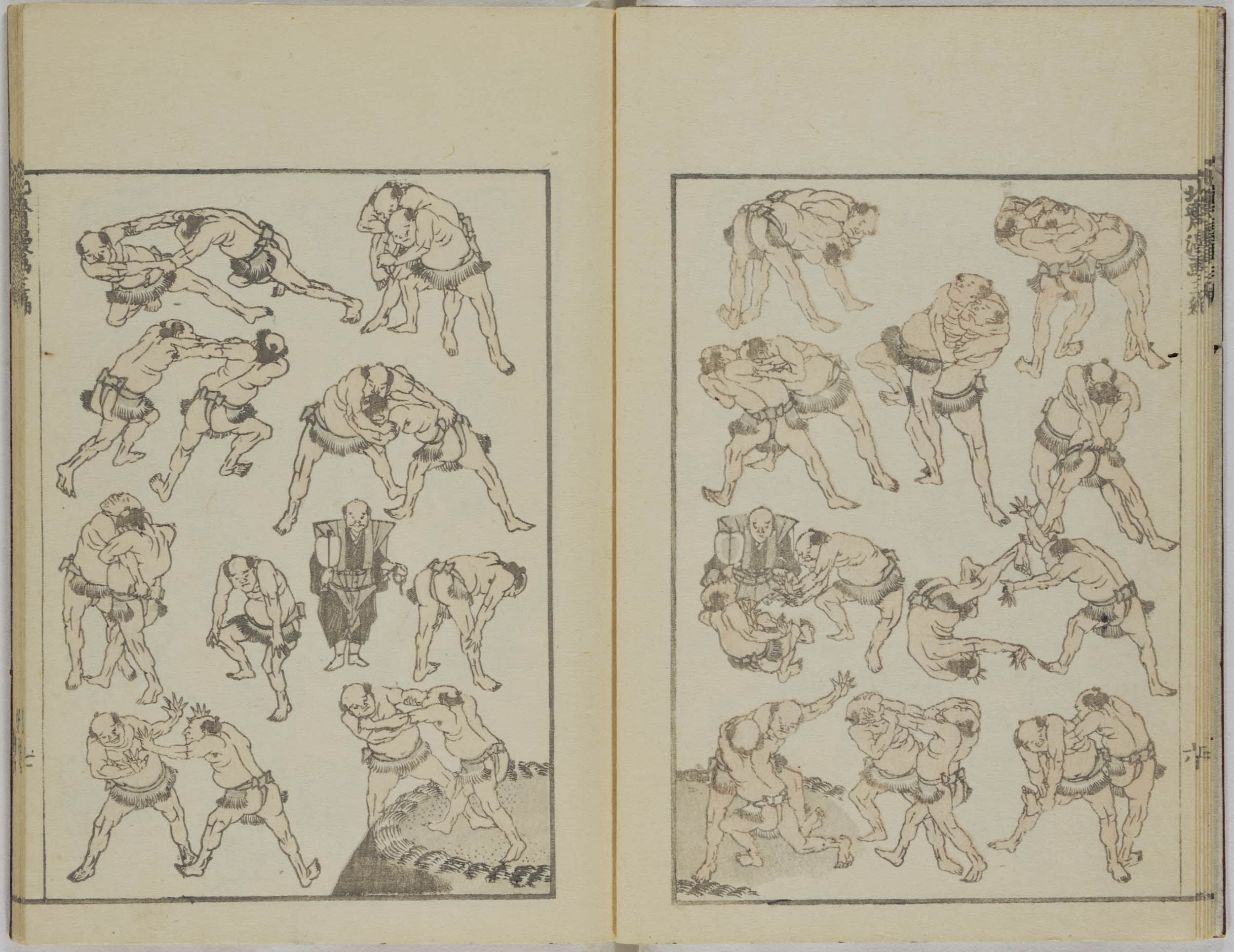
Maybe it's noise, but it's something I thought it would be interesting to mention. Because perhaps the same can be applied to Poussin and by tracing artistic influences perhaps the network of contacts and the traffic of ideas can be investigated or expanded, which would allow to mark specific points in time/space and thus revise history.
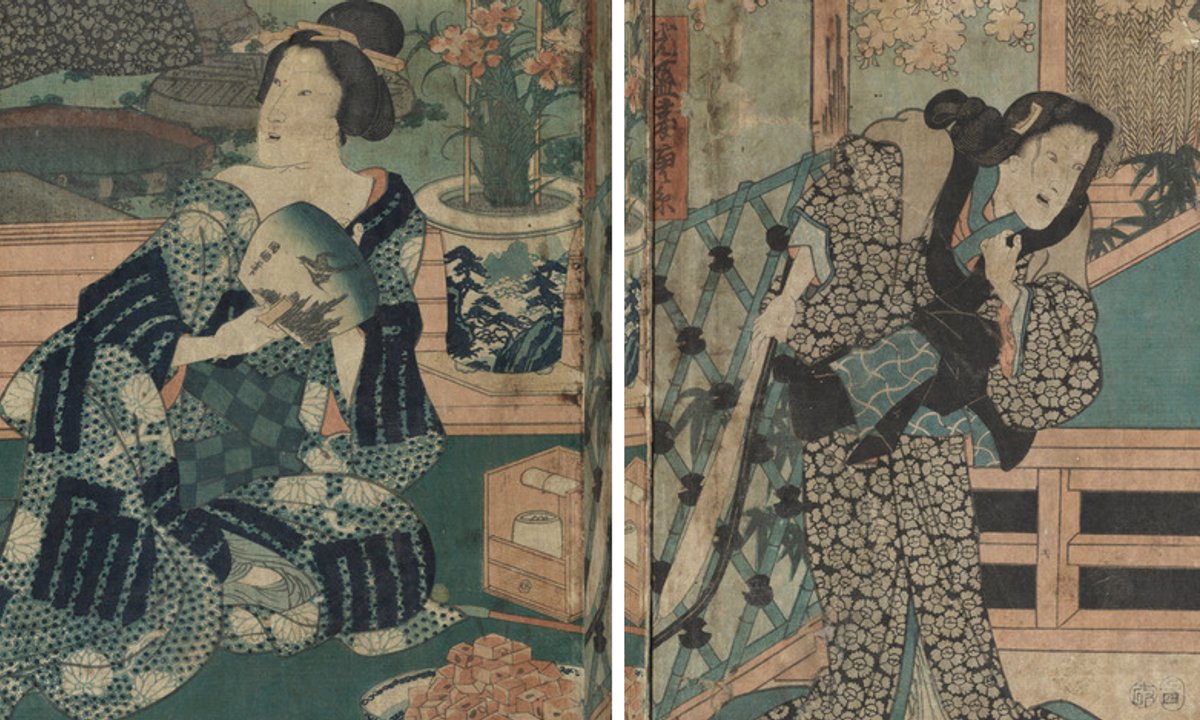
Gauguin and Van Gogh: their shared love of Japan revealed
“Beautiful women” in Gauguin’s rediscovered manuscript are now identified as by Kunisada—Vincent’s favourite Japanese printmakerwww.theartnewspaper.com
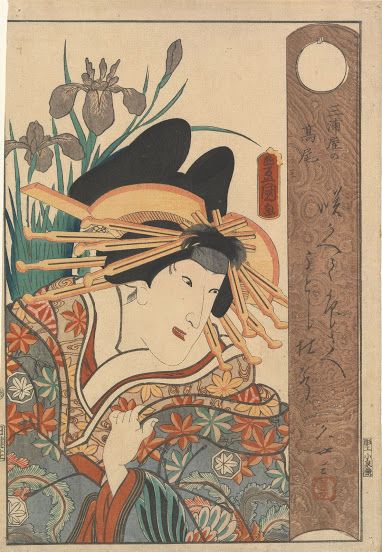
Look the flower in that japanese painting!
dennis
Jedi Council Member
that there never was an Israelite king called Solomon and his character was based instead on the Egyptian pharaoh called Narmer who famously united the two kingdoms of Egypt
Check out the pharaonic head dress of the lower kingdom and upper kingdom of Egypt. Red and white like the two houses in Britain. Flower symbolism may be an analogy for various genetics as well as uniting the lower material body (red) with higher spirit (white). As far as biblical symbolism goes, Egypt is considered as material (Khem) is it not?
Hedjet (Ancient Egyptian: 𓌉𓏏𓋑, romanized: ḥuḏat, lit. 'White One') is the White Crown of pharaonic Upper Egypt. After the unification of Upper and Lower Egypt, it was combined with the Deshret, the Red Crown of Lower Egypt, to form the Pschent, the double crown of Egypt. The symbol sometimes used for the White Crown was the vulture goddess Nekhbet shown next to the head of the cobra goddess Wadjet, the uraeus on the Pschent.[1]
In the Bible, the rose of Sharon is a poetic reference to a flower that is native to the region of Palestine. The reference is found in the Old Testament’s Song of Solomon, which is a love poem that speaks of the beauty of the beloved. In the poem, the rose of Sharon is used as a symbol of this beauty.
These references to the rose of Sharon have also been interpreted as a symbol of Christ. This interpretation is based on the belief that the Song of Solomon is an allegory of the love between Christ and the Church.
- The Song of Solomon 2:1 says, “I am the rose of Sharon, the lily of the valleys.”
- The Song of Solomon 2:2 says, “As a lily among thorns, so is my love among the daughters.”
- The Song of Solomon 5:13 says, “His cheeks are like beds of spices, banks of sweet herbs: his lips like lilies, dropping sweet smelling myrrh.”
rose of sharon symbol

A 12th century Persian poet wrote, “Mystery glows in the rose bed, the secret is hidden in the rose.” Not surprisingly, the rose has long been recognized as the western equivalent of the eastern lotus as a symbol of the unfolding of higher consciousness.
In medieval Europe, the Rose as a symbol of union with the divine may have been influenced by Arabian and Persian teachings from the time when Spain was an Islamic country. The Sufi teacher, Hazrat Inayat Khan writes:
Just as the rose consists of many petals held together, so the person who attains to the unfoldment of the soul begins to show many different qualities. The qualities emit fragrance in the form of a spiritual personality. The rose has a beautiful structure, and the personality which proves the unfoldment of the soul has also a fine structure, in manner, in dealing with others, in speech, in action. The atmosphere of a spiritual being pervades the air like the perfume of a rose.
The Rose and the Grail | Rose Symbolism
One of the most beautiful and significant symbols of the Western Mysteries is the Rose. The Rose and the Grail share many spiritual resonances. The word chalice comes from the Latin word, calyx, which means cup.www.chalicecentre.net
Hello, MJF. Fleur de Lis is a schematic representation of the Vajra/Vajara - the weapon of the ancient gods of India.The 'Fleur de Lis' is itself an interesting symbol since it may have an underlying connection to the triad looking plasma discharges that can occur in nature, which can resemble a trident (Trent?) in appearance. As the C's said, our ancestors may have seen such plasma discharges in the sky and been in awe of them. The Fleur de Lis is supposedly based on the lilly flower, which is also the symbol of the House of David and of the Virgin Mary and Saint Joseph (who was descended from the House of David) who is often depicted with a lily.
Nobody knows for certain when the Fleur De Lis symbol was first designed, though it has been found on seals and coins dating as far back as the 10th century A.D.
However, some French scholars believe the flower may originally have been an iris (see below). Apparently, the French or Franks, before entering Gaul, had lived for a long time around the river named Lys in Flanders. Nowadays, this river is still bordered with an exceptional number of irises which have yellow flowers, which is not a typical feature of lilies. The Fleur de Lis was the symbol found on the French Royal Standard or flag until it was replaced in the French Revolution by the Tricolour. Many noble Norman families also adopted the Fleur de Lis within their family crests and my own Norman family was no exception.

An Iris compared with the fleur-de-lis emblem
And as Bluegazer noted the three-pronged Ψ sign represents the PSY symbol and the wave function in quantum mechanics and is also a symbol for Antennae in electronics. Hence, there could have been an ancient, occulted scientific principle underlying the Ψ symbol, which subsequently found expression in the Fleur de Lis.
In addition to India, this image is found on many temples of Antiquity (these temples were appropriated by the ancient Greeks, and before them by the Hittites - neither one nor the other built these temples, of course) and in the Middle East. For example, here is an image from Didim/Didymos (Turkey) - this is the largest marble temple of antiquity:
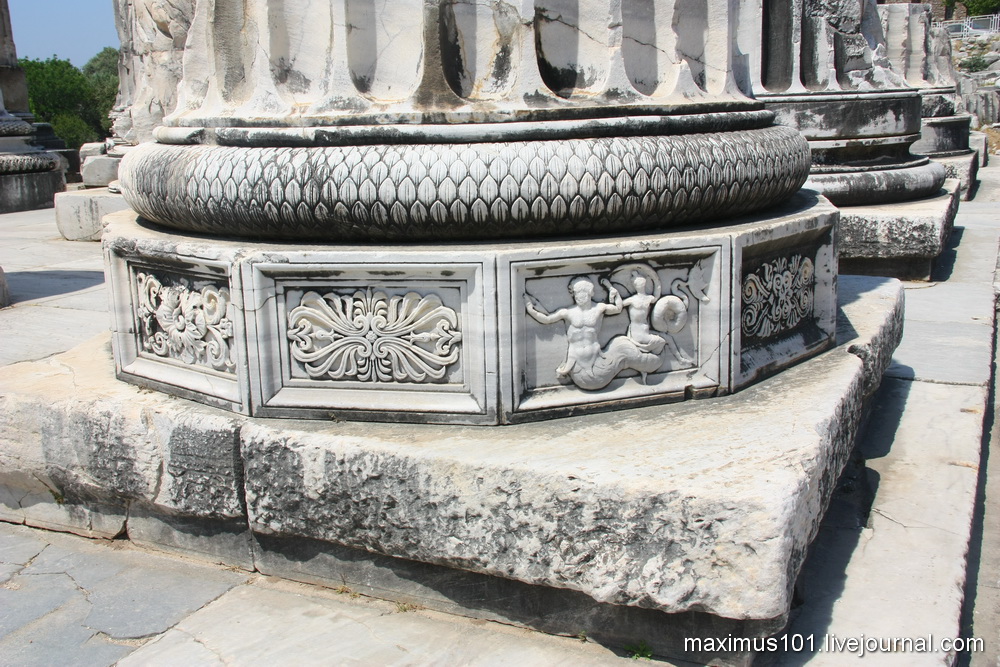
In addition, in Didymos there are many images of the head of the Gorgon Medusa -
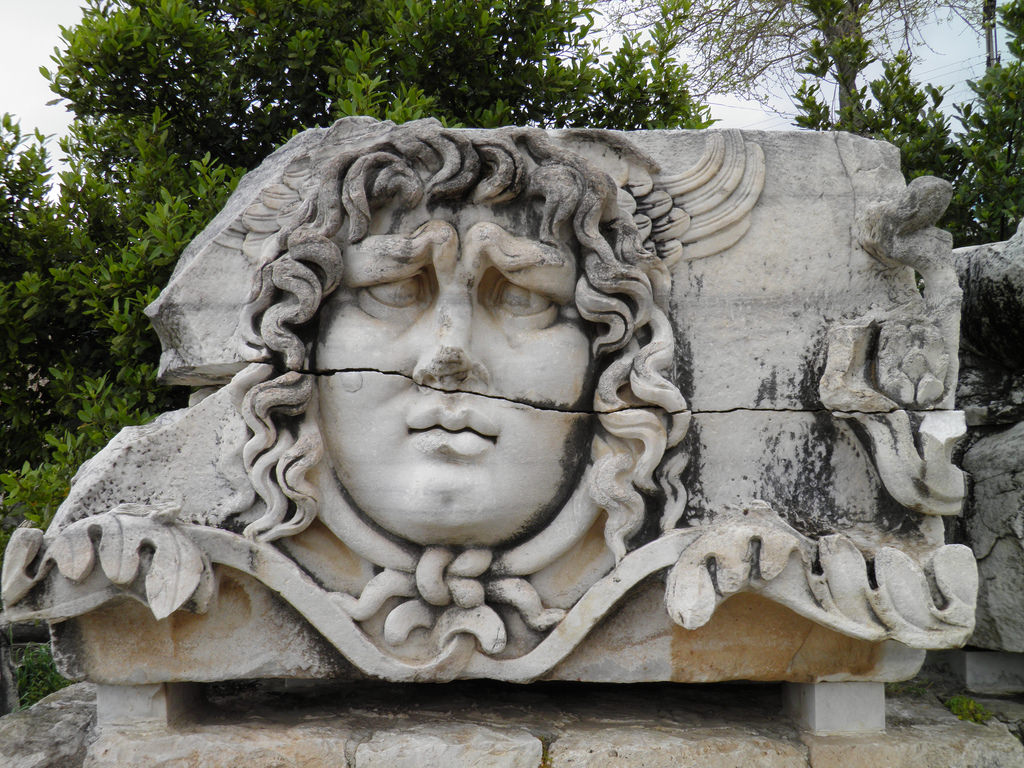
Didymos, along with Delphi (a much smaller temple in Greece) was a temple where the priestess/oracle Pythia predicted the future for people.
From Wikipedia:
According to legend, here at the place (Didymos), where the oracle was located, the beautiful Leto gave birth to a son, the god Apollo, from Zeus. Later, here Apollo appeared before a local shepherd named Branchus(Branch), and endowed the latter with the gift of prediction. From this shepherd originates the Carian priestly family of the Branchidae, who headed the temple economy until the beginning of the Greco-Persian Wars. Later, people from noble families of Miletus became priests here.
In the forest, Branchus kissed Apollo, who gave him a wreath and a staff. Depicted as a hunter, next to a dog and a hare, Apollo looks at him
----------------------
There, in Turkey, there is a curious amphitheater in the city of Kibyra (an interesting name of the city, isn’t it?), where a stunning mosaic (masterpiece) with the Head of the Gorgon Medusa was recently unearthed:
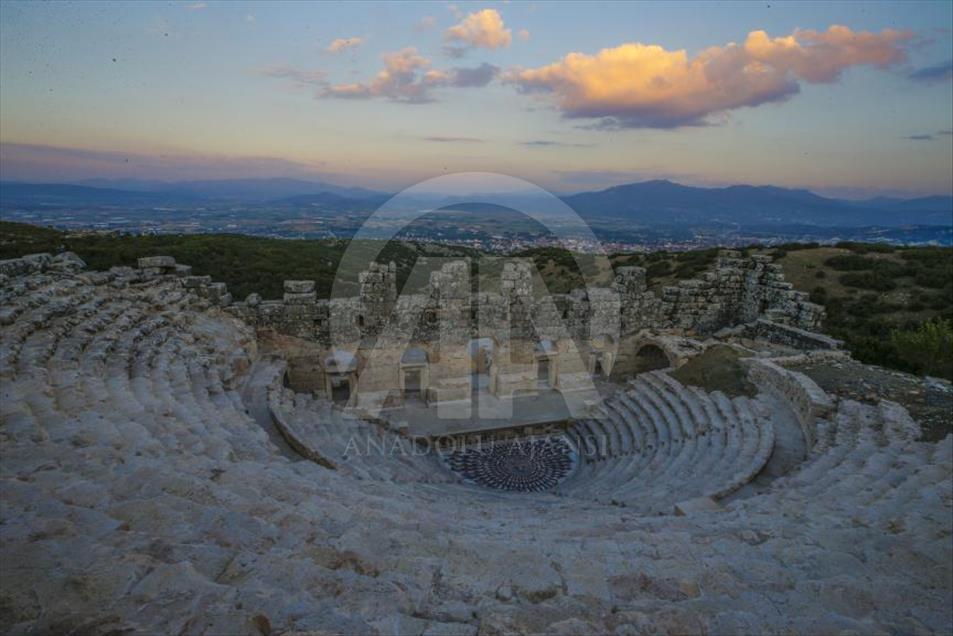
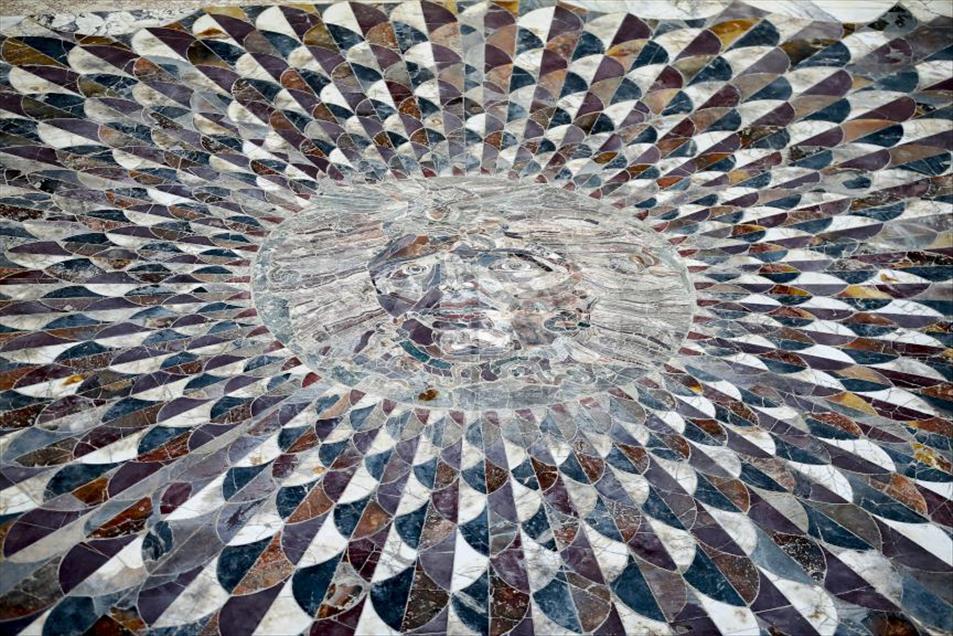
Three-dimensional mosaic, it’s better to watch the video -
What does this remind you of? Crystal glow

So let's add up everything we have:
1) The head of the Gorgon Medusa (sounds similar to the Grail, doesn’t it), which Perseus stole (and according to a later version, the demigod Hercules stole the head). The Gorgon's head could turn living matter into stone with its gaze. (Transdimensional Atomic Remolecularization - as one of the functions of the skull?)
2) MJF's guess that the Grail was a skull (and C's clue that "the skull was made of pure crystal")
3) An ancient mosaic that shows the glow of the head of Medusa the Gorgon (like the glow of a crystal through which light passes).
4) Shepherd Branch, who was “endowed with the gift of prediction” (Apollo gave him the Head of Medusa/Crystal Skull) - “and so, who was Brachna? - C’s.” From C’s we know that the device could only be controlled by a person with a sufficiently developed consciousness, moreover, the orientation is STO. We need a guy (or woman) with the right sexuality and genetic pedigree.
Thus, the history of the grail/crystal skull extends hundreds, if not thousands of years beyond the period that MJF was able to trace in this topic
To summarize, we have a shepherd guy (Abraham/Moses/Hittite moon worshiper? - or was it his more ancient ancestors?) who was given the Grail/Head of Medusa by the god Apollo.
It may also be possible that Branchus of Didymos was not related to Abraham/Moses - the story of Branchus could have taken place LONG before biblical times.
In principle, Abraham/Moses could have simply stolen the crystal skull (according to the old Perseus/Hercules tradition) on a “tip” from Yahweh from the territory of the Hittites (present-day Turkey).
There are a number of researchers who equate Yahweh and Apollo. If Yahweh=Apollo (jealous god), then the shepherd Brachne=biblical Abraham/Moses.
MJF, what do you think of this reptilian Star Wars guy?This suggests that the Seal of Solomon may originally have been an Egyptian symbol that went with the Israelites during their Exodus from Egypt under the leadership of Moses.Q: Who was the Queen of Sheba?
In my earlier post, I mentioned how Solomon was supposed to have harnessed through a magic ring or talisman the advanced talents, knowledge and skills of demons led by Asmodeus to build his temple. This may simply be a flowery explanation for Narmer obtaining assistance from certain aliens (was one of these an alien grey who called himself Ptah who possessed a magic levitating throne?). This connection between Narmer and aliens may be gleaned from the following exchange between the C's and Laura:
A: Fictional.
Q: Did a great queen come to visit King Solomon?
A: Alien influence.


Recently, I came across some interesting information that is difficult to verify. It can be either garbage/lies or true. Here's what one source says:
Yoda is a mysterious “spirit” with which all Masons of the world communicate, a demonic infernal entity from another dimension or a “superintelligence” AI.
Yoda from Star Wars Summoned demon from Masonic spell ritual
On the picture:

Eliphas Levi, a 33rd degree Freemason and renowned British occultist, is depicted here performing a demonic spell ritual to summon a demon (Mephistopheles, also known as "Yoda") into our space-time.
Culture comes from cult. Films and music are used for indoctrination. Star Wars director George Lucas is a high-ranking Luciferian Freemason. He made the demon Mephistopheles, also known as “Yoda,” a pop culture icon, leading millions to believe in a supposed universal “power.”
Ask Masons with a high degree of access to the “truth” who Yoda is and see the reaction.
This infernal Yoda = is the intermediary of the Masons with the other world, the infernal world.
Something like "Super Advanced" Google on doping.
What kind of order is that in the movie "Star Wars"? Order of the Knights Templar
This is the old “devil” Yoda, the same infernal who showed Solomon where the ancient temple was and how to enter it..
-------------------------------------
In an attempt to verify this information, Google finds a color picture from the book of the occultist Manly Palmer Hall, "An Encyclopedic Exposition of Masonic, Hermetic, Kabbalistic and Rosicrucian Symbolic Philosophy." It is in Russian translation and it literally says the following:

“Mephistopheles, the most famous of the spirits of evil, is often mentioned in connection with the search for Doctor Faustus. Goethe defines Mephistopheles as “a part of that force that does good without number, desiring evil for everyone.” The majestic figure of the super-seducer, familiar to all opera lovers, is not genuine Mephistopheles. The Secret Archives of Magical Art contains the names and descriptions of all magical demons and methods of controlling them. About Mephistopheles it is written: "He is under the rule of Jupiter, and the name of his regent is Zadkiel, one of the throne angels of the Holy Jehovah. He can be made to appear in the early morning on Wednesday (the day and hour of Jupiter) or in the evening of the same day. He appears first in the form of a fiery bear, and a less striking and more pleasant incarnation of him is a small bald man in a black hat. " The Mephistopheles of ceremonial magic, arising from the spell of a magician, appears before him as an ugly dwarf, but woe to the wizard who falls under the power of this tiny creature."
Last edited:
BHelmet
The Living Force
This is the classic beauty face I was mentioning in the Troy thread. (So what if it is supposedly Medusa.) Def not Italian or Greek. So who from where? Full lips dimple chin full jaw Celtic? Is this what the druids looked like? Northern euro? Looks like the face of a cathedral builder to me. Not Gauloise? A bit Valkyrie Germanic? The Aryans? The real Athenians from somewhere. Ideas?
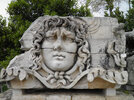

moyal
Jedi Master
The name 'Yoda' appears to me a spoiled mixture of Yodh-Aleph (Hebrew letters; read left to right) and ''Adonai" (read right to left).Here's what one source says:
Yoda is a mysterious “spirit” with which all Masons of the world communicate, a demonic infernal entity from another dimension or a “superintelligence” AI.
Yoda from Star Wars Summoned demon from Masonic spell ritual
Also, "all Masons" is pretty hysterical.
You can supposedly buy a 33°, provided you have the necessary change.
This is not even like finding and then decorating yourself with grandpa's Iron Cross from the attic and then thinking you're an Über-soldier.
It's actually more like just dusting it off at a garage sale.
Hello. There are quite a lot of such faces/statues made of granite in St. Petersburg. They are called ATLANTS. The most famous “hold the sky” in the city center, near the Hermitage:This is the classic beauty face I was mentioning in the Troy thread. (So what if it is supposedly Medusa.) Def not Italian or Greek. So who from where? Full lips dimple chin full jaw Celtic? Is this what the druids looked like? Northern euro? Looks like the face of a cathedral builder to me. Not Gauloise? A bit Valkyrie Germanic? The Aryans? The real Athenians from somewhere. Ideas?
They were allegedly made in the mid-19th century (when there was no electricity or modern grinding machines). The statues survived the Siege of Leningrad (World War II), when most of the city was destroyed by German bombing.
Atlanteans/Giants/Titans/Kronids (children of Kronos)/Asuras and Devas (in India)/Nephilim (in the Bible) - they are called differently in different countries.
The largest number of such sculptures/faces is located in the territory of modern Turkey (in Asia Minor and other parts), and not in Greece. These statues are mostly made of marble (not granite) and are of normal human height; very few giant statues survive.
Well, if you believe games like Assassin’s Creed Valhalla, then in England during the Viking attacks (9th century) there were ancient temples of enormous size with giant statues. And already in the 9th century these were huge ruins (that is, very ancient even in those days). Probably due to the climate (rains/winds and other things), nothing there has survived to this day.
PS I apologize to MJF for intruding on his topic. I continue to closely follow his research.
moyal
Jedi Master
It's hard to tell from the picture, but they seem to be EXACTLY the same. Practically 'copy and paste'.
At least I wouldn't be able to do this myself if I was only given a hammer and chisel.
This is true. In Turkey and Greece there are many identical sculptures of Hercules (demigod), some researchers of antiquity joke about the “factory for the production of Heracles”, as if they were stamped on an assembly line.It's hard to tell from the picture, but they seem to be EXACTLY the same. Practically 'copy and paste'.
I'm afraid that it will not be easy to process granite (this is Serdobol gray granite, 200 km from St. Petersburg to the north) with a hammer and chisel - it is extremely hard (but at the same time fragile, it cracks when chipped). You need carbide tools (tungsten and cobalt) as well as diamond cutting and grinding/polishing tools.At least I wouldn't be able to do this myself if I was only given a hammer and chisel.


